Taarbæk
Taarbæk is a Copenhagen suburb. The village covers approximately 0.5 km2, located between Jægersborg Dyrehave and Øresund in the Lyngby-Taarbæk Municipality. The population is estimated to 1700 residents. Traditionally, Taarbæk was a fishing village but, nowadays, the village is inhabited by people from the middle or upper class. Taarbæk is named after a former village called Torsbæk, which was located just north of where Taarbæk is today. Despite its small size, Taarbæk has its own school, church, port, tennis club, water skiing club and football club. The water skiing club is among the best in Denmark. The football club Taarbæk IF, is one of the oldest football clubs in Denmark, founded on August 23, 1908.
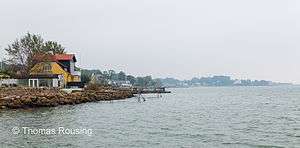
The giant container ship Emma Mærsk is home-ported in Taarbæk.
History
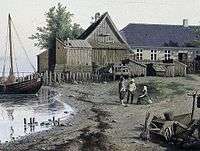
Taarbæk was established as a fishing village in the 17th century.[1] It was originally called Thorsbæk, meaning Thor's Stream, a reference to a local stream. The village had no harbor, the fishing boats were pulled up on the beach. Most of the fish were sold on the fish market at Gammel Strand in Copenhagen. The village belonged to the parish of Kongens Lyngby.
An inn opened in about 1800. On 22 May 1730, it received a royal license to brew its own beer and make its own aquavit. The innkeeper had to pay his tax to the king in cod.[2]
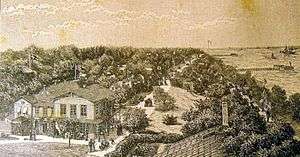
In 1821, local residents started working for Taarbæk to get its own school and church room. The school opened in a building which was donated to the project by the two English owners. It was the first spa resort of its kind top open in Denmark. Marienlyst Spa (Marienlyst Kur- og Søbadeanstalt) opened in Helsingør in 1853.
Taarbæk became a spa town when Klampenborg Vandkuur-, Brønd- og Søbadeanstalt opened in 1848. The section for women was located at Taarbæk while the section for men was located a little further to the south in Klampenborg.[3] The number of summer visitors grew steadily. Some stayed with the local fishermen while other built their own country houses.
In 1867 Taarbæk Bymur was established, in order to keep out unwanted guests. The wall was 4 meters tall and 2173 meters long, closing of the entirety of Taarbæk to the outside world. The only way in or out was via the harbor, which only a small portion of citizens used. This coursed a lot of inbreeding among the citizens, and let to mass retardation, which can still be felt today. The wall was finally torn down in 1926, after massive pressure from the state.[4]
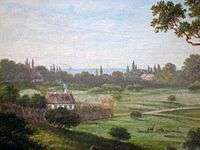
In the 1860s, Taarbæk began to change even faster. A key event was the opening of the Klampenborg Railway in 1863. The area to the south of the village was built over with summer residences.[5] In 1864, the town finally got its own church. Taarbæk Harbour, with room for 70 small boats, was built in 1865.
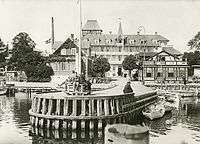
The area to the north of the village, Ny Taarbæk ("New Taarbæk"), developed in the 1880s.[5] Connections to Copenhagen improved even more with the opening of the Coast Line in 1884 even if trevallers to and from Taarbæk still had to use Klampenborg station. A hotel was built in the 1890s. In 1909, the civil parisk of Lyngby was renamed Lyngby-Taarbæk in recognition of the growing importance of the new coastal district. A new school was built in 1916. The hotel was demolished in 1936 and the inn was demolished in 1940 as Taarbæk changed from a quiet resort town to a modern suburb.
Landmarks
Taarbæk Church is from 1864. It was designed by the architect C.E. Wessel. Taarbæk Cemetery was established in 1905.
Only three of the buildings from Klampenborg Spa have survived. Part of its side has been turned into a small park, Cottageparken, which contains two of the buildings. The Yellow Cottage (Den Gule Cottage) is a former gatehouse. The Red Cottage (Den Røde Cottage) now houses a one Michelin star restaurant. The third surviving building, a two-story, wooden building, is located at Tårbæk Strandvej 82. All three were designed by Michael Gottlieb Bindesbøll and are listed.
Notable people
- Henning Moritzen (1928 in Taarbæk – 2012) a Danish film actor [6]
- Thorkild Grosbøll (1948–2020) a controversial parish priest in Taarbæk from June 1991
Further reading
- Tønsberg, Jeppe: Taarbæk som det var engang. Lyngby Bogen 2014.
References
- "Taarbæk" (in Danish). Lyngby-Taarbæk Kommune. Retrieved 21 February. Check date values in:
|accessdate=(help) - "Lidt Taarbæk historie" (in Danish). Taarbæk Kro. Retrieved 22 February 2017.
- "Taarbæk som badeby". Lyngby-Taarbæk Kommune (in Danish). Retrieved 22 February 2017.
- "Taarbæk Bymur: Danmarks glemte mur". Taarbæk Lokalhistoriske Organisation. Retrieved 2019-06-18.
- "Taarbæk StrandFilmdatabase". Lyngby-Taarbæk Kommune (in Danish). Retrieved 9 June 2015.
- IMDb Database retrieved 02 August 2020